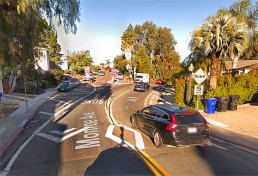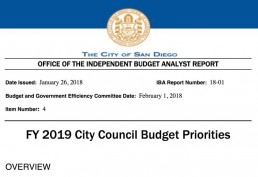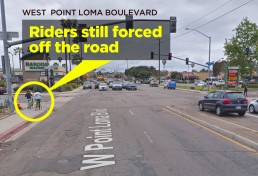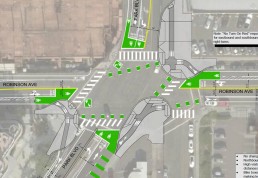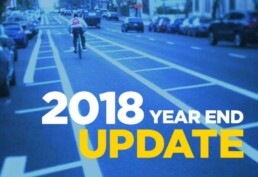Monroe Bikeway: A Bikeway on Paper Only
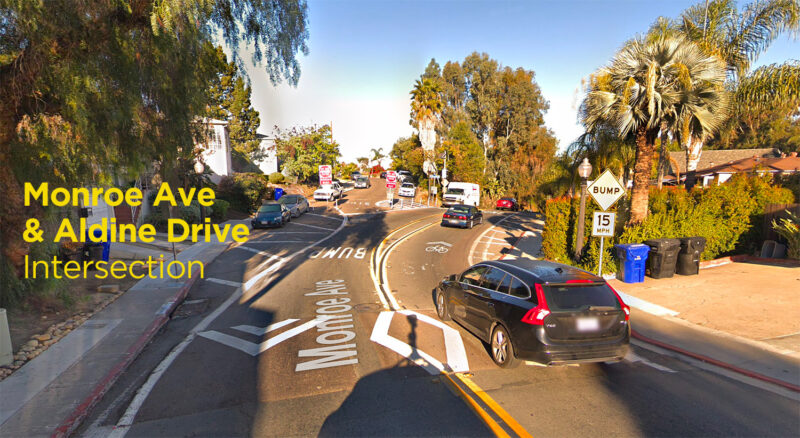
Back in July 2018, we knew the five year old planning effort behind the Monroe bikeway was in trouble. The Kensington-Talmadge community planning group (Ken-Tal) declined to vote on the latest version but they clearly resisted improvements to this corridor. Both Kensington-Talmadge and BikeSD were told that San Diego traffic engineers would study possible solutions to keep traffic on El Cajon Boulevard. It’s unclear if those studies were ever completed. BikeSD warned that Ken-Tal would not allow any solution that allowed for safer conditions on a route connecting Mid-City and San Diego State University area.
On a Friday afternoon, February 21, 2019, the San Diego Association of Governments (SANDAG) announced they were abandoning the current Monroe Bikeway effort.
- - -
Monroe Avenue was identified as a primary bicycle route in both the current Mid-City and College Area community plans. In SANDAG’s alignment analysis in 2014, Monroe was selected for its lower level of stress for bicyclists and its lower cost compared to a cycle track on El Cajon Blvd. At the time, BikeSD and others advocated for cycle tracks on El Cajon Blvd. However, SANDAG and City of San Diego choose to pursue the Monroe segment to connect North Park/Mid-City areas to the neighborhoods around San Diego State University.
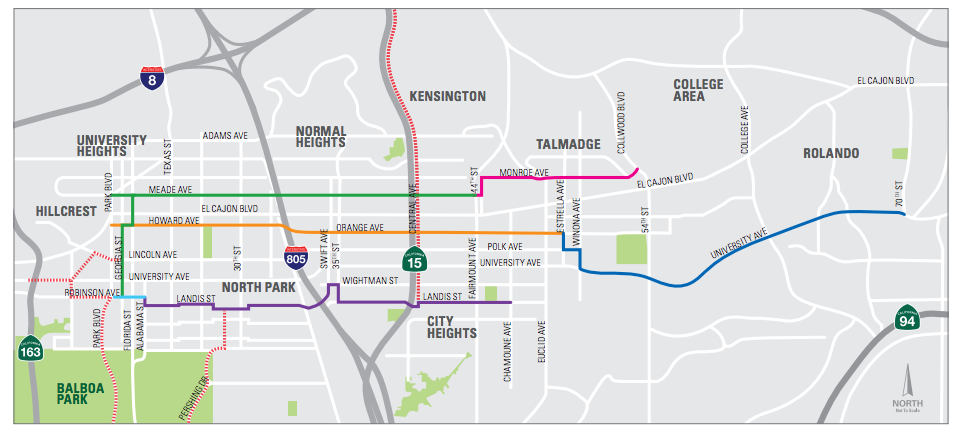
Most of the controversy about the planned bikeway is about the 0.1 mile section of Monroe Ave. from Aldine intersection to 47th street. While this section suffers from high automobile volume, is it really worth abandoning the remaining 1.2 miles of bikeway improvements?
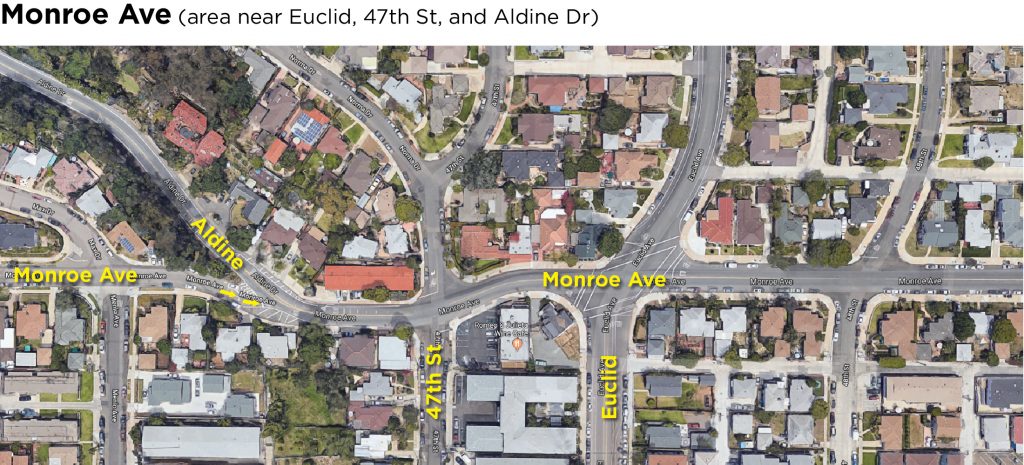
In the past five years, many designs for the intersection of Aldine and Monroe have been proposed but according to SANDAG emails, yet no design was “feasible” to meet of all the constraints imposed from various interested parties. The lack of consensus around a solution doomed the project.
Currently, westbound Monroe and Aldine is a tricky intersection. Aldine Drive is a one of three entry ramps that connect to the Interstate 8 freeway. Area residents also have Fairmount to the west and Collwood to the east, both higher capacity entry points than Aldine Drive. Cyclists traversing this corridor have few choices: dangerous El Cajon Boulevard to the south, or detouring very far south to Orange. Westbound bicyclists on Monroe currently have no legal route to continue on westward besides using the sidewalk.
SANDAG designed multiple concepts to allow Monroe to serve as an east-west bicycle boulevard:
1) Two-way cycletrack on south side of Monroe: (Potential designs here and here.) The possibility had support from some Ken-Tal planning group members who supported trying to prevent left turns from 47th St onto Monroe. However, City of San Diego instructed SANDAG that it would not support any modifications of 47th St. This prevented the design from further evaluation including solving potential challenges of narrow road width. This design was abandoned in 2015.
2) HAWK signal: In 2016 and 2017, SANDAG presented a HAWK signal to allow bicyclists (and pedestrians) to cross the intersection when a bicyclist triggers the HAWK. The Ken-Tal planning group asked for the HAWK removed in 2017. District 9 Councilmember Georgette Gómez’s office did not support the HAWK either. Both CM Gómez and Ken-Tal CPG were concerned about vehicle delay caused by the HAWK. It’s important to note that SANDAG presented traffic studies in 2017 that showed minimal delay (~2 sec). In 2018, it SANDAG presented different traffic model data but that model did not include analysis that included HAWK signal.
3) Bike left turn pocket: This design was SANDAG’s first concept design introduced in 2014. It’s simply a left turn pocket for bicycles only. It legalizes an action that some cyclists already make to continue westward on Monroe. This protected pocket would make it feel safer. It was reintroduced after the HAWK signal was removed from consideration upon Ken-Tal CPG request in 2017. However, City of San Diego traffic engineers rejected this concept in fall of 2018 due to limited sightlines and high traffic volumes. Considering neither sightline nor traffic have changed since 2014, why did City of San Diego engineers not relay their concerns about a bike turn pocket prior to 2018? The lack of communication between City of San Diego and SANDAG is a common theme throughout SANDAGs early action bike program.
4) Bike left turn pocket + 1/2 HAWK signal: An innovative solution proposed by SANDAG combining the turn protection of left turn pocket with HAWK beacon to stop southbound traffic and allow a safe crossing for cyclists. This solution would alleviate any fears about a HAWK signal effects on vehicle delay for Northbound morning commute. It also addressed the concerns of City of San Diego traffic engineers about sightlines. City of San Diego traffic engineers rejected this option.
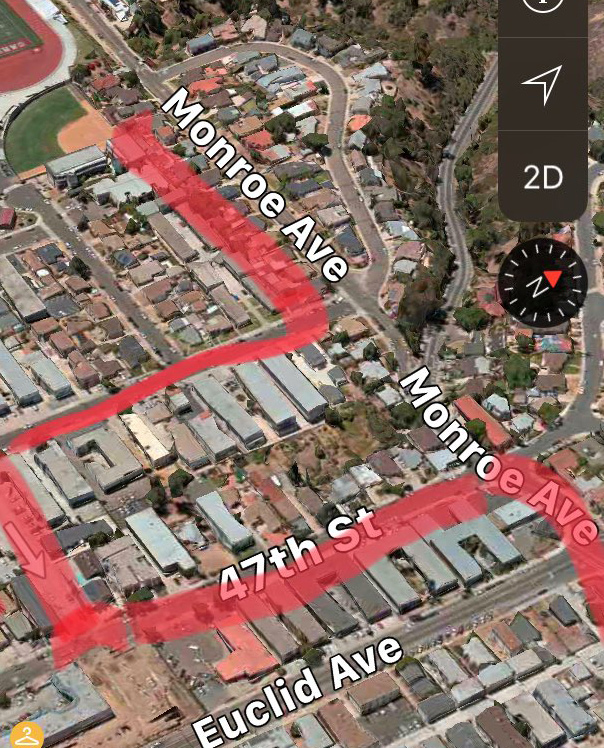
5 ) Meade Ave detour: BikeSD member Howard Blackson had another a suggestion: Why not avoid the tricky Aldine/Monroe intersection with a detour onto Meade Ave for a block (0.4 mile total detour)? The design would have to overcome the current one-way street design of Meade St for this block. Again, this was concept was rejected because City of San Diego would not allow any modifications to 47th St and Monroe intersection. SANDAG’s preferred solution would require some intersection modification to allow westbound cyclists turn safely southbound onto 47th St. (Update: this solution may be back in play.)
Can a future planning grant solve the problem?
The money designated for design phase of the Monroe Bikeway has been exhausted according to SANDAG. In the recent email blast, SANDAG and City of San Diego promised to search for future planning grant opportunities to find a alternative alignment.
Unfortunately, we have recent experience with a mobility planning grant in this exact neighborhood. The City of San Diego received a planning grant to improve mobility for pedestrians and cyclists along the section of El Cajon Blvd parallel to the planned Monroe Bikeway. Again the Ken-Tal planning group led the charge to have bicycle improvements removed from the plan. At the time (2016), Ken-Tal CPG members told KPBS that they supported bicycle routes on side streets, including Monroe but opposed them on El Cajon Boulevard. The Monroe bikeway suffered not because of a lack of funding but a unwillingness to prioritize bicyclists safety.
Until your favorite SANDAG bike project is in construction, everyone should be nervous of a Friday email that announces your neighborhood bike project no longer exists.
A Quick Look at FY 2019 City Council Budget Priorities
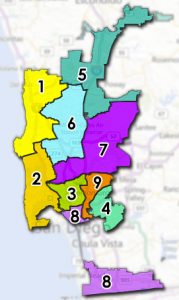 San Diego City Councilmembers submitted their priorities to the Office of the Independent Budget Analyst (IBA) in January 2019 and the IBA created a report which can be seen here: https://www.sandiego.gov/sites/default/files/18_01_fy_2019_city_council_budget_priorities_complete_report.pdf
San Diego City Councilmembers submitted their priorities to the Office of the Independent Budget Analyst (IBA) in January 2019 and the IBA created a report which can be seen here: https://www.sandiego.gov/sites/default/files/18_01_fy_2019_city_council_budget_priorities_complete_report.pdf
From the report:
"All Councilmembers indicated that support for the Climate Action Plan (CAP) is a priority in FY 2019, although no single-CAP related item was supported by a majority of Councilmembers. Budget priority memoranda included requests for adaptive traffic signals intended to ease congestion; additional staffing for the City’s Urban Forestry Program, Vision Zero program, and other CAP-related activities; a Community Choice Energy local buildout study; a mobility monitoring program to measure bicycle, pedestrian, and transit mode share; and the addition of CAP social equity metrics."

BikeSD is pleased that all Council members supported programs related to City’s Climate Action Plan and public safety including Vision Zero. But we continue to see a lack of clear direction with regard to exactly what projects should be prioritized. BikeSD Executive Director Judi Tentor spoke in favor of the Budget Priorities and encouraged Council to accelerate bicycle infrastructure projects as much as possible.
Councilmember Scott Sherman from the Seventh District was the only Councilmember who did not call out Pedestrian and Cycling Safety as a priority. All other Councilmembers cited many bicycle related infrastructure projects.
Eight Councilmembers prioritized projects in their memoranda designed to enhance pedestrian and cycling safety. A variety of requests were made as part of this priority including:
- Prioritizing funding for infrastructure improvements in the corridors identified as part of Vision Zero, especially the “Fatal 15” intersections
- Initiating traffic calming measures such as raised delineators or electronic (VCalm) signs
- Installing rectangular rapid flashing beacons, crosswalks, and constructing Safe Routes to Schools program improvements
This is good news. BikeSD will be reviewing bicycle infrastructure projects outlined in the report in the coming weeks. If we can hold the the Council to account on these projects, push for funding and accelerated timelines, we might come close to meeting our CAP goals for bicycle mode share. Maybe.
West Point Loma Blvd bike lanes: still no approval from PCPB

On Thursday night, staff from San Diego's Traffic & Storm Water Division (TSW) presented slides detailing the West Point Loma Blvd bike lane project to the Peninsula Community Planning Board (PCPB). The project encompasses a "road diet" on a 4-lane-wide stretch of West Point Loma Blvd., reconfigured to a 2-car-lane street with a Class 2 bike lane (paint-buffered only) and other traffic calming measures. This was the third presentation since October 2018 made by the city to the Peninsula community board about the West Point Loma Blvd. bike lane project. TSW's slideshow gave PCPB the results of their detailed traffic analysis, parking study data, lane configuration drawings, and Level of Service (LoS) impacts — all of which showed minimal impacts on drivers along the corridor — in an effort to win approval from the community board for the project.
Unfortunately, the PCPB did not approve the project, though it also did not make a motion of denial.
 Speakers in support of the project from BikeSD and San Diego County Bicycle Coalition urged the board to approve the bike facility. There were also others, including local residents on West Point Loma Blvd, that also spoke in favor of better bicycle facilities along this corridor.
Speakers in support of the project from BikeSD and San Diego County Bicycle Coalition urged the board to approve the bike facility. There were also others, including local residents on West Point Loma Blvd, that also spoke in favor of better bicycle facilities along this corridor.
There were also a handful of residents that were opposed or had questions. Two audience members took issue with the term "road diet," and insisted that this should be called a "lane removal." Board members' questions focused on issues of traffic delay, the 'back-in/angled parking' configuration, the decline from a Grade B to a Grade C 'Level of Service', and the 'math not working out' when a car lane was removed. These questions were challenging for TSW staff, who gave technical answers that didn't mollify critics on the board.
Many of the PCPB board members shared desire for better bicycle facilities but still wanted to critically discuss specific design elements. Nicole Burgess of BikeSD said, "I think some them truly want to be traffic engineers."
In the end, there was no vote on the project but the board passed a motion calling for the City to return and discuss it further at the PCPB Transportation Subcommittee.
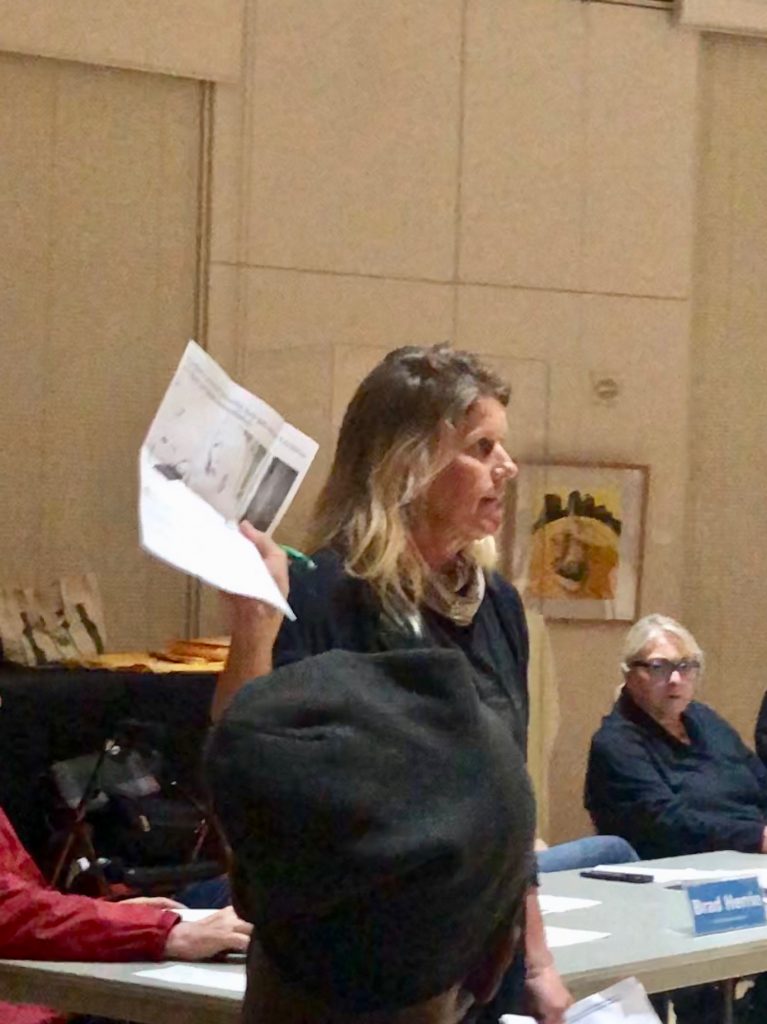 Nicole Burgess wrote San Diego Mayor Kevin Faulconer immediately following the meeting, "I believe the City has done due diligence and provided adequate information as they have presented three times now at the PCPB. Also, as a reminder, the OB Planning Group unanimously supported a road diet to provide safe bicycle facilities."
Nicole Burgess wrote San Diego Mayor Kevin Faulconer immediately following the meeting, "I believe the City has done due diligence and provided adequate information as they have presented three times now at the PCPB. Also, as a reminder, the OB Planning Group unanimously supported a road diet to provide safe bicycle facilities."
BikeSD believes that Level of Service (LoS) should not be the focus of presentations about bike infrastructure, just as it has been removed as a valid topic for CEQA studies. LoS leads to a very narrow discussion about the impact on drivers and travel-time rather than safety and the equitable use of public rights-of-way. Instead, the Vision Zero Systematic Solutions for Safety should be the leading guideline for these types of improvements. We can not let Community Planning Groups make final decisions for the safety measures needed for our streets to meet Vision Zero and CAP goals.
The West Point Loma bike facility was originally proposed by the Bicycle Advisory Board back in the spring of 2018, with unanimous support for the project. For the safety of all road users, BikeSD is hopeful that Mayor Faulconer and Councilmember Jennifer Campbell will advocate for this type of improvement in their community. We applaud TSW's proposed striping plans and believe this Class 2 bike lane is an essential piece of the puzzle to fill in the gap along this corridor.
Yes! I support BikeSD's advocacy for safety. Tell me about becoming a member...
(Plus, receive a free BikeSD t-shirt with every membership, while supplies last.)
Park Boulevard Bikeway - open house & traffic safety hearing January 8
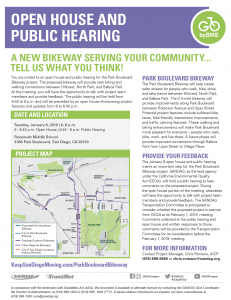 Mark your calendars for the January 8th open house and hearing about SANDAG's proposed Park Boulevard Bikeway Project. This event is focused on presenting the recently-completed Park Boulevard Traffic and Safety Impact Assessment.
Mark your calendars for the January 8th open house and hearing about SANDAG's proposed Park Boulevard Bikeway Project. This event is focused on presenting the recently-completed Park Boulevard Traffic and Safety Impact Assessment.
Date/Time:
Tuesday, January 8, 2019
6 – 6:45 p.m. Open House
6:45 – 8 p.m. Public Hearing
Location:
Roosevelt Middle School
3366 Park Boulevard
San Diego, CA 92103
The Traffic and Safety Impact Assessment being presented at the open house has some very interesting bike and pedestrian path designs. Below is an image of the current intersection at Park Blvd. and Robinson Ave. Below that is a drawing from the Traffic Study showing how the new bike path is configured at this same intersection. The proposed bike lanes come up onto the corner bulb-outs and cross through the pedestrian space (taking the rider out of traffic lanes for many movements through the intersection). Please take a look at the Traffic and Safety Impact Assessment for more eye-opening details on this new bikeway.
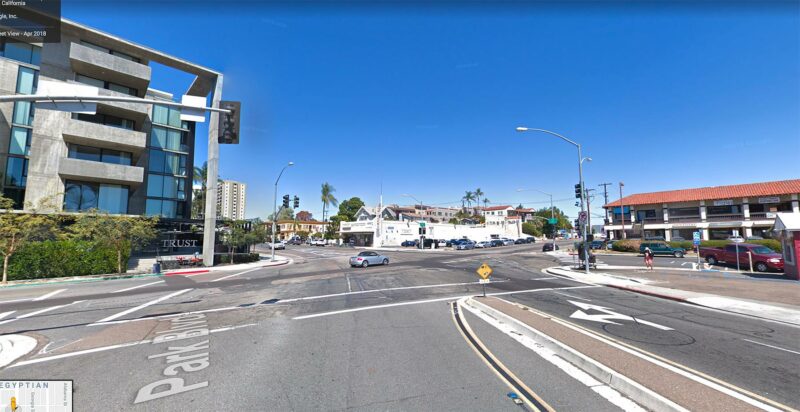

SANDAG's Transportation Committee is anticipated to consider whether the proposed project is exempt from CEQA at its February 1, 2019, meeting. Comments collected at this public hearing and open house (as well as written responses to those comments) will be provided to the Transportation Committee for its consideration before its February 1, 2019, meeting.
SANDAG's project director believes the Park Boulevard bikeway has broad community support and doesn't expect much, if any, opposition to the design. Nevertheless, we encourage all BikeSD members with an interest in the Park Blvd bikeway to attend and give their input. Support for bikeways in San Diego is never something to be taken for granted so it's important for bike advocates to speak in favor of these facilities at every public hearing.
Hope to see you there on Tuesday at 6 pm!
BikeSD Campaigns 2018 - End of Year Report
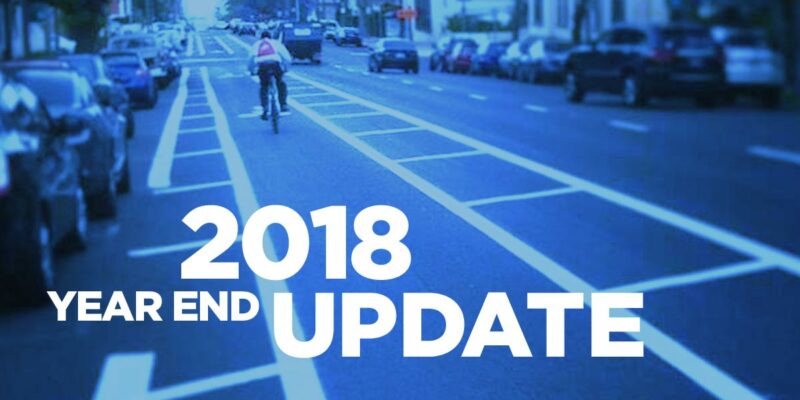
BikeSD saw progress on a number of local campaigns for bike infrastructure in 2018 — as well as a few delays and setbacks. Here's the end-of-year scoop on several of them:
Downtown Mobility Plan hits the ground
The first phase of downtown San Diego's bikeway was striped in late December with great fanfare. New two-way cycletracks along J Street are just the start, though finishing all three planned phases of the project will take sustained effort. Get the full scoop on progress to date on this central set of bikeways.
BikeSD gets Gilman Dr. some buffered bike lanes
A last-minute opportunity arose during a sewer replacement by UCSD along Gilman Drive in La Jolla: bike lanes with buffered space could be added after the road was resurfaced by the University. Read about BikeSD's successful presentation to the UC Planning Group and where this led on the safety of the Gilman Dr corridor.
Potential 30th Street Bikeway
A grassroots campaign called 'Right Side Club,' founded by Matt Stucky, pushed for a better north-south bike facility on the eastern side of Balboa Park. The city's current bike Master Plan on the east side were lackluster so Matt laid out a better plan for a bike facility along 30th Street. Check out some great thinking on this potential alignment.
SANDAG's Hillcrest Bikeway is modified
A recent push by City Councilmember Chris Ward's office to create a park-like urban space in Uptown, called "The Normal Street Promenade," has pushed back SANDAG's timeline for the Eastern Hillcrest Bikeways by 3 to 6 months. But the Promenade has led to some interesting changes in the bikeway design along Normal Street. Perhaps more importantly, the Promenade has created community-wide alliance to that's invested in seeing SANDAG's Phase 2 bikeways completed in full.
Balboa Avenue Station
The Balboa Ave Area Specific Plan has been one big disappointment to transit, pedestrian, and bike advocates. A large parking lot, car-centric station design, poor access from points west like Pacific Beach, a narrow and difficult access ramp for non-drivers. Read about our efforts to get changes in the Balboa Station plan.
Border to Bayshore Bikeway
BikeSD was at the SANDAG transportation committee meeting to advocate for this important connection and to encourage MTS to work with SANDAG where a new rapid bus line will intersect with bike infrastructure. Project information here.
Yes! I support BikeSD. Tell me about becoming a member...
(Plus, receive a free BikeSD t-shirt with every membership, while supplies last.)

